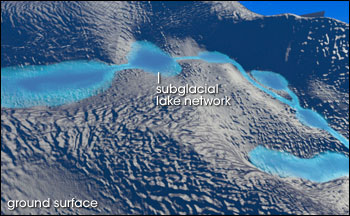

Water Greases the Skids | |||
Yet the discovery of this complex, subglacial water network means more than water squishing around under Antarctic ice. The location of the network under a fast-flowing ice stream means that water likely plays an important role in how quickly the ice overhead moves on its path to the sea. “We know intuitively that water lubricates the ice stream and reduces the friction,” Fricker explains. “If you have more water under an ice stream, it will flow faster. We know there should be some influence on flow speeds, and ultimately that’s going to affect how fast the ice flows off the continent and therefore sea level rise.” Given those expectations, what actually appeared to be going on beneath the Whillans Ice Stream was rather odd. “While one isolated lake lost about two cubic kilometers of water, all the other lakes gained about an equivalent amount of water,” says NASA scientist Robert Bindchadler. “But it’s not the same water because the lake that lost water is downstream of the other lakes and in a separate basin.” The amount of water that accumulated in the other lakes is nearly equal to all the water that pressure and geothermal heat could likely have produced under the Whillans Ice Stream during that period. “Yet—and here’s the really odd part—,” he emphasizes, “this ice stream is slowing down at a consistent rate of about 1 or 2 percent per year. Now if water is the lubricant that lets ice go fast, why, if there is more water, is the ice stream going slower? We have ideas how to answer this, but the seeming contradiction shows us that we don’t understand this system yet.” |
|||

It is a system that climatologists studying the impact of global warming on sea-level rise want to understand better. While the Antarctic and Greenland ice sheet systems are irrevocably tied to Earth’s climate in many ways, Fricker and her collaborators all point out that subglacial lakes have no direct relationship to Earth’s steadily rising temperatures. “We’ve actually got evidence that there were features similar to this in the 1980s on the same ice stream, from photographs.” But even though the lakes are not caused by climate change, their role in “greasing the skids” beneath ice sheets and glaciers will have to be factored into models of how the Earth’s icy landscapes will react to global warming. That those models need a lot of improvement before they can produce more than just broad estimates of sea-level rise was made clear in February 2007. The same month that the scientific magazine Science published Fricker and her colleagues’ paper on subglacial lakes, the Intergovernmental Panel on Climate Change (IPCC) released a summary of its 2007 report. Even though the panel strongly affirmed the link between greenhouse gases and rising global temperatures, it had to qualify its predictions of future sea level because “understanding of these [ice-sheet] processes is limited, and there is no consensus on their magnitude.” |
Water moving between subglacial lakes can explain elevation changes in ice stream surfaces. Lakes typically form in low-pressure areas under the ice. See animation for more. (Image courtesy Susan Twardy, NASA Goddard Space Flight Center.) | ||
 | |||
Scambos expects that ice sheet contributions to sea level will be significant, but he agrees with the IPCC’s decision to avoid specific predictions at this point. “We’re still learning about all of the things that are contributing to flow off these ice sheets,” he says. The discovery of a complex “plumbing” system beneath the ice sheet is clear evidence of that. “Stuffing this information into models will be a real challenge, but it is what we [snow and ice scientists] need to do before we can help out the next IPCC report.” For Fricker, the obvious next question is whether this kind of subglacial plumbing system exists all over Antarctica. Fricker and Scambos both admit that they don’t know. But they plan to find out. “We’re going to map the whole ice sheet. We’re going to do a continent-wide survey and find out where all the active regions are,” she says. The drive to have results in time to provide input for the next IPCC report, just a few years down the road, can make scientific progress feel like a race. While the map of Antarctica’s subglacial waterways is incomplete, Scambos says, “We’ve fired the starting gun.”
|
Melting of ice sheets and crumbling of ice shelves will influence sea level as Earth’s climate warms. Understanding the influence of subglacial lakes on ice flow will help scientists better model the behavior of ice streams and ice shelves and to predict how they will respond to global warming. (©2005 BrynJ.) | ||